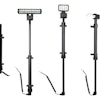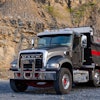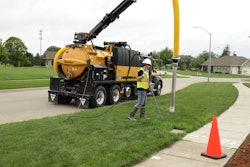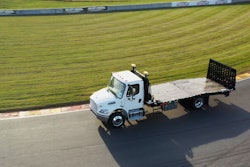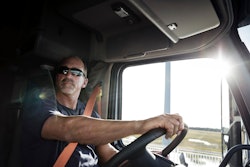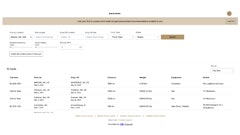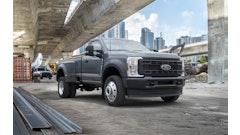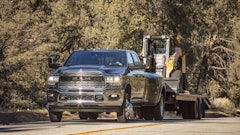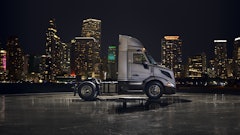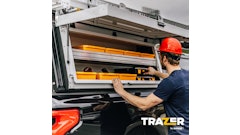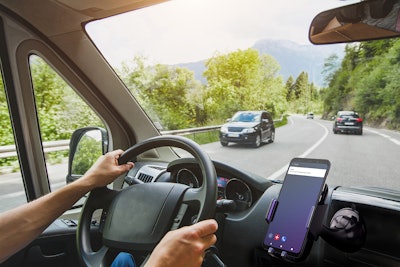
Distracted and inattentive driving are leading causes of vehicle-related accidents as the influx of mobile technologies competes for drivers’ attention. There are in-cab solutions that not only help minimize multi-tasking during critical drive time, but also detect drowsy driving, aggressive driving and threats from other vehicles on the road.
Solutions exist that can help manage mobile technology use while behind the wheel. One example is TRUCE Software.
“TRUCE is all about providing employees with the right mobile features and functionality at the right time,” says Joseph Boyle, TRUCE CEO. “It all boils down to the individual employee’s context, such as their proximity to heavy equipment, work group and time of day, for example. Mobile device permissions adjust automatically and in real time as the employee’s environment changes throughout a shift.”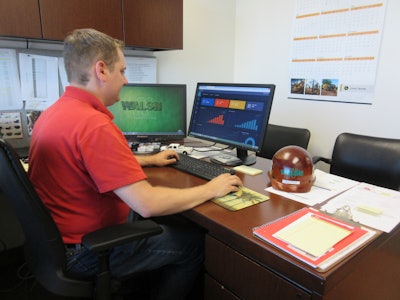 Walsh Construction uses the Contextual Mobility Management administrative portal to design policies and view insights into the types of activities being managed and blocked by the system.The Walsh Group
Walsh Construction uses the Contextual Mobility Management administrative portal to design policies and view insights into the types of activities being managed and blocked by the system.The Walsh Group
What is okay for an employee to do with a device while in the break room, for example, is different from what might be considered appropriate use when driving a vehicle. The company sets its mobile use policy and TRUCE simply helps to enforce that from a tech standpoint. No monitoring or manual intervention is involved.
“Dynamic enforcement of an employer’s mobile device policy based on each employee’s real-time context helps ensure workers are safe and productive, while still giving them the freedom to keep their mobile device on them throughout a shift,” explains Boyle. “At TRUCE, we don’t believe phone bans in work environments are the answer.”
Situational App Use Drives Safety
Trying to limit use through broad company policies has not proven very effective. “A flexible solution is needed that allows you to understand, define and enforce different use policies for different environments,” says Boyle.
For example, when an employee is on a jobsite, they may need access to certain applications. When that employee is in a vehicle, access to most applications, except hands-free calling, can be temporarily restricted. “You can use turn-by-turn directions as long as you’re not typing in the address while you are driving,” notes Boyle. “And you can listen to your music and podcasts, for example, but your ability to check emails or work orders while driving is withheld until the employee is no longer driving.”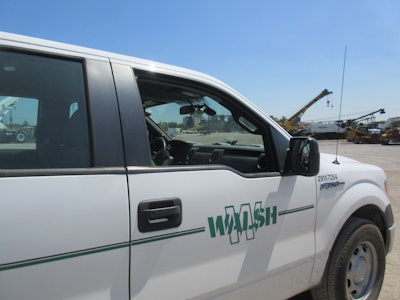 Walsh Construction is requiring use of Truce Software's Contextual Mobility Management for anyone with a company-issued vehicle. The goal is to reduce driving distractions that can lead to vehicular incidents.The Walsh Group
Walsh Construction is requiring use of Truce Software's Contextual Mobility Management for anyone with a company-issued vehicle. The goal is to reduce driving distractions that can lead to vehicular incidents.The Walsh Group
The use will be determined by the employer policy. “It’s all about your acceptable use policy,” says Boyle. “How does that change situationally? You define those policies in [TRUCE’s} application and then we bring them to life.”
The technology relies on contextual indicators. It is more about context than location. “We are not interested in monitoring where people are. There are tracking technology companies that do that,” Boyle states. “We are interested in making sure employees are getting safe and productive use out of their technology. It’s about getting what you want out of the mobile device and not having the by-products.
“We go after the root cause of the issue, which is we’re addicted to our devices. We stare at them constantly — most of the time not even realizing that we’re doing it,” he comments. When employees can’t access unnecessary apps, that behavior changes. “They put the phone away and focus on the task at hand.”
The results speak for themselves. “Our customers typically see between a 30% to 40% reduction in accidents after deploying TRUCE,” says Boyle.
Dash Cam Technology Keep Drivers Alert
Beyond mobile technology distractions, there are other factors such as driver fatigue and aggressive driving habits that can lead to increased risk. In-cab camera technologies have proven an effective solution to address these issues, as well as protect drivers and companies from liability from accidents caused by other roads users.
“Camera technology has been around for some time,” says Mayank Sharma, head of global product management and UX, Teletrac Navman. “With the advent of the smartphone, it’s become mainstream on the consumer side and it is everywhere. Obviously, there is overflow into the commercial side.”
It started with recording videos on SD cards and has progressed to connected dash cams that give real-time access to video data in the cloud using mobile apps or the web. “The benefits are that you can see all the way from prevention of accidents to reducing accidents,” says Sharma.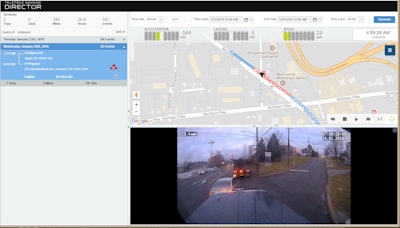 The Teletrac Navman DIRECTOR Event Viewer feature, paired with dashboard camera footage, can be used for a full view of unsafe driving events to coach drivers on driving behavior or acquit the driver of being at fault.Teletrac Navman
The Teletrac Navman DIRECTOR Event Viewer feature, paired with dashboard camera footage, can be used for a full view of unsafe driving events to coach drivers on driving behavior or acquit the driver of being at fault.Teletrac Navman
On one side, this technology proactively reduces accidents. “The other side is more incident management or incident capture so that you can coach drivers, which will ultimately results in safer driving and on-road behavior,” Sharma explains. “Those are the two spectrums, but in the middle there are a ton of other benefits for the fleet manager.”
Driver retention is among these benefits. “If your fleets are generally safer you can retain drivers longer,” notes Sharma.
Insurance is another benefit. “There is actually a connection between using this data and going to your insurance company to say my fleet is safer and my premiums should be lower based on how my drivers drive,” Sharma points out.
Maintenance costs can also be reduced. “How you drive safer is by not braking too much, not cornering too harshly,” says Sharma. “That helps you with maintenance costs, which is sort of an implicit benefit, as well as fuel reduction cost. So, today there are a whole host of benefits that come from adopting dash cams, and especially connected dash cams, in your fleets.”
Dash cam technology presents a clear picture of driving events. “First of all, video provides visual proof and context around telematics-triggered events,” says Andrew Rybak, business development manager, marketplace, Geotab. “For example, it can reveal what the driver was doing when a harsh braking event occurred. Also, the dash cam can be used to exonerate a driver. Video captured by dash cam can be used as evidence when a driver is incorrectly deemed at fault for an accident.”
Omnitracs reports that 85% of collisions are not the fault of the commercial driver.
But dash cam technology does increase safe driving behaviors, as well. “The installation of a dash cam can immediately reduce accidents or close calls through alerts for unsafe behavior,” says Rybak. “Some drivers will also be more mindful knowing that a camera is monitoring their driving.”
Not all dash cams are the same. “There are wide varieties of technologies that range from dash cams that simply record audio and video to capture information in and around the vehicle, to more proactive safety systems that are integrated with the vehicle,” says Jason Palmer, GM of transportation intelligence, Omnitracs. “These safety systems will alert the driver if they are distracted, fatigued, following too close or unsafely maneuvering the vehicle. Events from the advanced systems can then be analyzed by driving experts to determine if the driver needs additional training.”
There are reactive and proactive systems. “Reactive systems that simply record what is happening in and around the vehicle are primarily focused on recording situations for exonerating the driver,” notes Palmer. “For those systems that are more proactive in measuring driving performance and alerting the driver, they can have an immediate impact in reducing collisions.”
The driver-facing camera is important for implementation of proactive systems. “Dash cam technology can provide proactive driver alerts for distracted or drowsy driving as long as there is a driver-facing lens and the driver system monitoring (DSM) is enabled,” says Rybak. “For fleets unwilling to capture what is going on inside the cabin, they do have options. They may install a road facing-only dash cam, block the driver-facing camera or use the driver-facing camera as a sensor that does not capture video. However, the most effective approach to keeping everyone safe usually includes a road- and driver-facing camera.”
The inward-facing camera is very focused on driver behavior. According to Sharma, phone usage is the most commonly recorded violation captured, followed by seat belt use. The camera is able to detect if the driver is wearing the seat belt or not.
The return on investment in dash cam technology should be immediate. “We expect our customers to realize immediate results when deploying video-based AI (artificial intelligence) technology,” says Rybak. “For example, AI-based video telematics can recognize when a driver is doing something risky, such as using their cell phone or following too closely, and immediately alert the driver.”
Recorded Infractions Drive Improvement
Cameras will give you a true picture of what is happening in the fleet. “With cabin-facing dashboard cameras, the most common events typically captured are cell phone use, drowsy driving, eating or drinking distractions, improper seat belt use and tampering with the camera,” says Rybak. “With road-facing cams, they can capture forward-collision warnings, stop sign violations, risky lane departures and unsafe following distance.”
Systems are becoming more sophisticated. “The most basic triggers are based on hard braking, cornering and speeding,” says Palmer. “More sophisticated systems will leverage computer vision and AI to measure driver inattention, fatigue, following distance, collision warning, U-turns and speeding.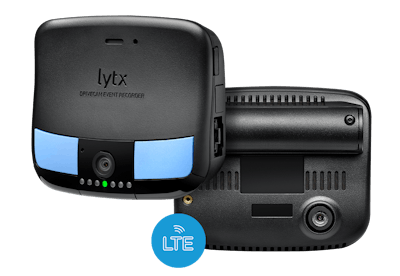 The DriveCam device mounted on the windscreen contains a forward looking lens and a lens focused on the interior of the cab. It also contains an accelerometer and other components to record data.Lytx
The DriveCam device mounted on the windscreen contains a forward looking lens and a lens focused on the interior of the cab. It also contains an accelerometer and other components to record data.Lytx
“Safety systems are now also leveraging streaming data in real time to measure impending inclement weather and can advise the driver when they may need to reduce speed,” he adds. “It can also monitor vehicle health and the location of a vehicle to dispatch maintenance when there is an issue where they are parked unsafely, ultimately to quickly intervene to get the driver to a safe location.”
AI technology can gauge the condition of the driver, as well. “We are able to track the iris, the eyeball direction where you are looking,” says Sharma. “Those technologies are available and they’re pretty mature. You are able to pretty accurately detect if the driver is distracted; it’s called engaged tracking. But there is also head tilt tracking. If your head is tilted down, you really can’t focus on the road. You are focusing on something else.” Audible alerts are used to get the driver re-focused.
Lytx DriveCam Event Recorders detect risk using a combination of sensors such as accelerometers, machine vision and artificial intelligence. “Accelerometers allow us to capture unsafe driving events such as hard acceleration, braking, speeding, cornering and high G-force events,” says Ofelia Chernock, senior product marketing manager, Lytx. “Machine vision and AI provide additional vehicle and driver movements that can help identify risky and distracted driving.
“Traditional sensors capture risky and inefficient driving. Lytx technology monitors for patterns of persistent driving behavior and selects representative highlights of video that users can use as coaching opportunities,” Chernock explains. “Events are triggered when the DriveCam Event Recorder sensors detect certain behaviors, unusual or abrupt movement or when prompted by third-party ADAS signals.”
The results again speak for themselves. “Typically, a Lytx client will see results within the first few weeks of implementing the video-based safety technology,” says Chernock. “In a recent study conducted with more than 1,500 vehicles this year, fleets saw a 50% reduction in handheld use within days of implementing our technology, a result that was sustained for more than 29 weeks.
“By addressing the root causes of collisions and near collisions, our clients have seen substantial reductions in claims, with many seeing up to 80% reduction in claims costs within a year of installing our system,” she adds. “Our clients can see a 300% ROI and up to 50% reduction in collisions.”
Dash cams can serve as a deterrent simply by their presence. “Drivers are more cautious,” says Sharma. “The dash cam is right there. There is an immediate drop in risky behavior.” But in order for successful implementation, you need to communicate with drivers. “It is just transparency. You need to be open with your drivers about what you are actually recording and for what purposes.”
Many of the concerns drivers express about this technology are the same expressed 15 or 20 years ago surrounding GPS tracking technology. “That concern is still there, but I think largely now people understand the benefit,” Sharma comments. “I think camera technology is going down the same path.
“It is really about using coaching and transparency with your employees,” he continues. Explain the purpose and use examples. “Show examples where it actually prevented an accident or it saved somebody after the accident.” Also demonstrate cases where the driver is exonerated because the video shows the driver was not at fault.
Dash Cams Enhance Telematics Data
Dash cam technology adds a new level of capability to telematics data.
“Traditional telematics software that merely identifies G-force triggers, such as excessive braking or swerving, produces results that do not tell the whole story. Video evidence from dash cam technology exposes more than regular telematics could ever do,” says Chernock. “This is where we have seen big gains in safety and productivity over the past 20 years. Once you layer on technologies like machine vision and AI, the value of video grows exponentially. We can now identify whether a driver is distracted by their phone, drives through a stop sign, forgets to fasten their seat belt, is smoking while transporting hazardous or combustible cargo and so much more.
“In addition, understanding what happened in the lead-up to an unsafe or risky event, for example, enables fleet safety managers to paint a complete picture of the driver’s risk profile as well as the fleet’s risk profile — all the while, moving toward an improved safety culture,” she notes. “With precise, accurate data, fleet safety managers can proactively detect risky driving habits and correct them through personalized or self-coaching, reducing the likelihood of potentially dangerous road incidents.”
Real-time monitoring through integrated technologies can proactively prevent accidents. “Only advanced safety systems that incorporate computer vision, telematics and sensors can consistently measure driver alertness,” says Palmer. “The (Omnitracs) SmartRecorder4 or SR4, our 2nd-generation system, measures driver distraction to alert drivers in real time, as well as notify the driving expert if the situation persists so that they can proactively manage the situation.”
But there is a balancing act. Too many alerts coming from multiple devices can actually cause the warning devices to become the distraction.
“Because we are starting to see a breadth of safety alerts in the vehicle, it is important to integrate with the vehicle to only alert the driver from one system,” Palmer acknowledges. “For example, if the vehicle has a forward collision warning system, the dash cam will not confuse the driver by offering up duplicate alerts at the same time. With the growing breadth of potential alerts that may be given to the driver at any time, visual or text to speech alerting ensures that the driver clearly understands what they are being asked to do at that time.”
Dash cam technology is available for all fleets. “Every fleet can benefit from dash cam technology since there is not a fleet that is 100% risk-free,” says Rybak. ROI varies with each client’s unique situation. There is no one-size-fits-all when it comes to dash cams or video telematics. “We have seen interest from some fleets that are prone to legal or reputational risk, such as those with branded trucks. Another group of companies that realize the biggest return on investment are the self-insured vehicle fleets, as they pay the full cost of each and every accident.”
Dash cam technology helps reinforce a safety culture. “It becomes part of the larger story and safety culture for the organization,” says Chernock. “Many of our clients find both hard ROI in the form of fewer claims, lower vehicle maintenance costs, better fuel efficiency and reduced workers’ compensation claims. But they have also found ‘soft’ returns as well, such as a stronger safety culture where workers do the right thing even when no one is watching or better communication and trust between drivers and fleet managers.”
There are many distractions as today’s drivers attempt to multi-task, and mobile technologies often compete for attention. In addition, drivers often face tight deadlines, which can lead to aggressive driving. As we have shown, there are in-cab technology solutions that can help discourage aggressive driving while keeping your drivers focused on the road.

